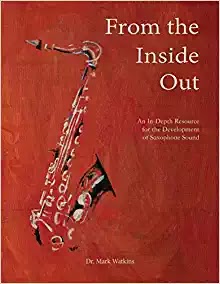I've recently read From the Inside Out, a book that I feel is one of the most important contributions to saxophone playing and teaching ever. The author, Mark Watkins, has spent 23 years researching the inner workings of saxophone playing. He's taken myriads of fluoroscopy videos, essentially x-ray videos, showing what happens in your body as you play the saxophone. He also used in-mouth cameras and sensors to measure airspeed to investigate the physiology and physics of sax playing. The book was just published last year, and Watkins has also made a series of videos accompanying the book available which show the inner workings of various fundamental and extended techniques.
Myths: Airspeed and Direction
In the first chapter of the book, Watkins challenges the common conceptions of speeding up the air or changing the direction of the airflow with the tongue or vocal cords. Changing airspeed with the tongue has always been my go-to explanation of voicing. Like many others, I've always thought that you raise the tongue to speed up the air, essentially shooting it at the mouthpiece. Watkins destroys this misconception and argues that tongue and vocal cord position, instead of affecting airflow speed or direction, affect the acoustics of the vocal tract with a resulting effect on your saxophone playing. It's an argument rooted in physics and his research that proves itself even more useful to saxophone playing than traditional voicing pedagogy (i.e. the traditional take on tongue and vocal cord position).
For example, the typical pedagogy is that the higher the note, the faster the air needs to be. Essentially, the tongue should be high enough to create a fast enough airstream to execute high notes. Meanwhile back in reality, sensors close to the reed show that airspeed does not increase for higher notes. In fact, for some professional saxophonists, the airspeed slightly decreases in the upper register. Using fluoroscopy imaging, Watkins also shows that the tongue isn't necessarily getting higher in the mouth for high notes. Similarly, he shows that the idea of changing the direction of the air with the tongue doesn't work physiologically, and references acousticians who demonstrate that the diffusion of air before it reaches the reed makes airflow direction negligible. However, both of these mistaken notions point to the very correct idea that moving your tongue is essential for good saxophone playing.
Reality: Tuning the Vocal Tract
What research has shown is that the position of your tongue and vocal cords tune the vocal tract, meaning the space in your mouth and throat back to your vocal cords. That tuning affects the sound, pitch, etc. that the saxophone produces. If the tuning is bad enough the notes won't sound (think low or high notes that don't speak nicely).
To very briefly sum up the general tendencies Watkins found, for low notes the back of the tongue is high in the mouth, and as you ascend in pitch the tongue moves forwards towards the reed and lowers for the middle register and raises a bit for the palm keys. The vocal cords are somewhat open for low and middle register notes and very close together for high notes. I found this very interesting because I'd arrived at fairly similar conclusions for tongue position, but I was pretty ignorant of how the vocal cords operated.
In a future post, I'll go into more specifics on the research on voicing and what I've found in practicing and teaching. For now, just obliterating the common idea about airspeed is good enough for one post!


Hello,
ReplyDeleteI'm glad I saw your post on facebook.
I'm actually finishing my master thesis about the relationship between vocal tract and the tongue. Looking forward for more development on this topic, it's a pedagogical concept that we tend to ignore.
Thank you for your contribution!
I am Pedro Pereira, by the way. Cheers.
DeletePedro, nice to hear from you. I’d love to hear about what you learn from research for your thesis.
DeleteLooking for quality PPMET entrance coaching online? Mantram Nursing Academy offers interactive online classes, live doubt-solving sessions, and comprehensive test series to help you ace the exam. Our experienced faculty ensures an engaging and effective learning experience, making nursing entrance preparation accessible from the comfort of your home.
ReplyDeleteOnline PPMET Entrance Coaching in Jalandhar